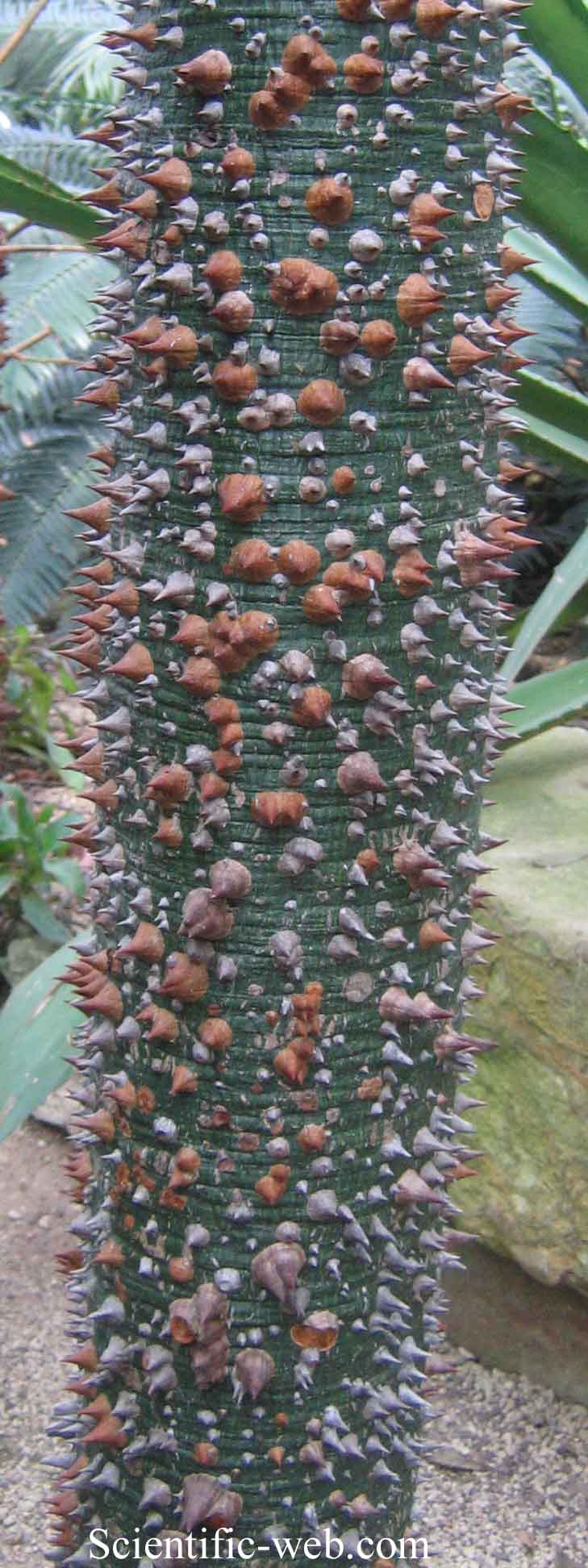
Ceiba speciosa, Photo: Michael Lahanas
Classification System: APG IV
Superregnum: Eukaryota
Regnum: Plantae
Cladus: Angiosperms
Cladus: Eudicots
Cladus: Core eudicots
Cladus: Rosids
Cladus: Eurosids II
Ordo: Malvales
Familia: Malvaceae
Subfamilia: Bombacoideae
Tribus: Bombaceae
Genus: Ceiba
Sectio: C. sect. Ceiba
Species: Ceiba speciosa
Name
Ceiba speciosa (A.St.-Hil.) Ravenna (1998)
Synonyms
Basionym
Chorisia speciosa A.St.-Hil., Pl. Usuel. Bras. 63. 1827.
Heterotypic
Ceiba rosea (Seem.) K.Schum. in Mart. (ed.), Fl. Bras. 12(3): 205. 1886.
Chorisia rosea Seem., Bot. Voy. Herald 84. 1853.
Chorisia speciosa var. minor Chodat, Bull. Herb. Boissier 7, App. 1: 67. 1899.
Chorisia speciosa var. paraguariensis Hassl., Bull. Herb. Boissier ser. 2, 7: 176. 1907.
Spirotheca allenii (Woodson) Cuatrec., Revista Acad. Colomb. Ci. Exact. 9(35): 167. 1954.
Spirotheca codazziana Romero, Mutisia 26: 7, f. 1, 2, 4. 1959.
Spirotheca rhodostyla Cuatrec., Phytologia 4: 465. 1954.
Spirotheca rimbachii Cuatrec., Phytologia 4: 467. 1954.
Spirotheca rosea (Seem.) P.E.Gibbs & W.S.Alverson, Brittonia 58(3): 253. 2006.
Spirotheca salmonea Ulbr., Notizbl. Bot. Gart. Berlin-Dahlem 6: 160. 1914.
Spirotheca trilobata Romero, Mutisia 26: 12–14, f. 3, 5, 6. 1959.
Xylon roseum (Seem.) Kuntze, Revis. Gen. Pl. 3(3): 24. 1898 [1].
References
Ravenna, P. 1998. Onira; Botanical Leaflets 3(15): 46.
The Plant List 2010. Version 1. Royal Botanic Gardens, Kew and Missouri Botanical Garden. Published on the internet. Accessed: 2012 Sep 15.
USDA, ARS, National Genetic Resources Program. Germplasm Resources Information Network - (GRIN) [Online Database]. [2]
Vernacular names
English: Silk floss tree
español: Palo borracho
suomi: Pullokapokkipuu
magyar: Hernyóselyemfa, brazíliai kapokfa
português: Paineira
Ceiba speciosa, the floss silk tree (formerly Chorisia speciosa), is a species of deciduous tree native to the tropical and subtropical forests of South America. It has several local common names, such as palo borracho (in Spanish literally "drunken stick") or árbol del puente, samu'ũ (in Guarani) or paineira (in Brazilian Portuguese). In Bolivia, it is called toborochi, meaning "tree of refuge" or "sheltering tree".[2] It belongs to the same family as the baobab and the kapok. Another tree of the same genus, Ceiba chodatii, is often referred to by the same common names.
Description
The natural habitat of the silk floss tree is in the north-east of Argentina, east of Bolivia, Paraguay, Uruguay and southern Brazil. It is resistant to drought and moderate cold. It grows fast in spurts when water is abundant, and sometimes reaches more than 25 metres (82 ft) in height. Its trunk is bottle-shaped, generally bulging in its lower third, measuring up to 2 metres (7 ft) in girth. The trunk is also studded with thick, sharp conical prickles which deter wild animals from climbing the trees. In younger trees, the trunk is green due to its high chlorophyll content, which makes it capable of performing photosynthesis when leaves are absent; with age it turns to gray.[3]
Leaves, stems, and flowers
The branches tend to be horizontal and are also covered with prickles. The leaves are composed of five to seven long leaflets. The flowers are creamy-whitish in the center and pink towards the tips of their five petals. They measure 10 to 15 centimetres (4 to 6 in) in diameter and their shape is superficially similar to hibiscus flowers. Their nectar is known to attract insect pollinators, as well as hummingbirds.[4] C. speciosa flowers are in bloom between February and May (in its native Southern Hemisphere), but can also bloom at other times of the year. The flowers of the related C. chodatii are similar in form and size, but their color goes from creamy white centers to yellow tips.[3] As a deciduous tree, it is completely bare of leaves and flowers during the winter months, especially when growing outside of its native South America habitat.
Fruits
The fruits are lignous ovoid capsules, 20 centimetres (8 in) long, which contain bean-sized black seeds surrounded by a mass of fibrous, fluffy matter reminiscent of cotton or silk.[3]
Uses
The "cotton" inside the capsules, although not as good quality as that of the kapok tree, has been used as stuffing (density = 0.27 g/cm3). The wood can be used to make canoes, as wood pulp, and to make paper. The bark has been used to make ropes. From the seeds it is possible to obtain vegetable oil (both edible and industrially useful).
The floss silk tree is cultivated mostly for ornamental purposes. Outside of private gardens around the world, it is often planted along urban streets in subtropical areas such as in Spain, South Africa, Australia, northern New Zealand and the southern USA, although its prickled trunks and limbs require safety buffer zones, in order to- protect people and domesticated animals.
Ceiba speciosa is added to some versions of the hallucinogenic drink Ayahuasca.
References
"The Plant List: A Working List of All Plant Species". Retrieved 2 July 2015.
"The Legend of the Toborochi Tree - Silk Floss Tree - Bolivian Myths and Legends".
Gibbs, P. E.; Semir, J. Año (2003), "A taxonomic revision of the genus Ceiba Mill. (Bombacaceae)", Anales del Jardín Botánico de Madrid, 60 (2), doi:10.3989/ajbm.2002.v60.i2.92, ISSN 0211-1322
"Archived copy". Archived from the original on 2015-09-21. Retrieved 2016-03-17.
Retrieved from "http://en.wikipedia.org/"
All text is available under the terms of the GNU Free Documentation License

